Holiday World – Santa Claus, Indiana
Besides trying to establish the roller coaster experience as a credible artistic medium while also attempting to present contrarian viewpoints that occasionally aim to challenge conventional enthusiast axioms, the third goal of this webproject of mine was to be as personally truthful with my writing as possible. Reading others journals of trips to parks foreign and familiar to me, I always hope that I can sample wearing their shoes and live through their life for just a few moments, but am ultimately always let down when I realize they choose to keep me at a distance with rhetoric and cliché replacing any genuine mining of the emotional core of the ride experience. Too much time was spent feeling alienated from fellow enthusiasts, wondering what it really feels like to look at the world through a different set of eyes, that I swore when I started Roller Coaster Philosophy I wouldn’t let that happen to my readers. While this site is still in its relative infancy as I write these words, I can already say that I’ve failed miserably at this third goal.
Some of it is through my own fault… mistaking ‘length’ for ‘analytical complexity’, or using rhetorical devices to stand in for actual critical thinking, and churning out mind-numbingly repetitive moment-by-moment analyses that do little to illuminate any larger issues at hand. But part of it comes from a much larger, epistemological dilemma that, as a part-time coaster reviewer and amateur philosopher, I am constantly faced with whenever I sit down to write my next analysis. Namely, what is truth? When you break it down in terms of what we know about the actual fabric of the universe, to try to apply any sort of rationalist method to determine if something is ‘true’ or not seems to be based on purely human abstractions that have no fundamental relationship to the actual world we are describing. Or perhaps truth doesn’t need to be based on what ontologically is but only on the mathematical, logical relationships between distinguishing characteristics whether they be completely imaginary or not. In either case, are all attempts to describe what we perceive as truth equally deceptive, or is there a way to at least approach truthfulness even if we may never actually get there. And even if we do happen find some sort of ultimate truth, how will we actually know that we have found it, because doubt can always seep in unbiased to whether something is actually true or not. In this case it seems our understanding of truth is much more dictated by passions than by logic; it is easy to become wrapped up in a rationalist, Platonic ideal, and look at a coaster progression structure and declare, “yes, the sequencing patterns are mathematically beautiful and the experience does tap into a key emotional core of our being, therefore we have uncovered a higher truth about this ride that clearly demonstrates it to be more perfect than other, lesser designs!” But these elated feeling of understanding based on romantic ideals of what is structure or beauty eventually disintegrate with doubts over whether these ideals are merely human-crafted illusions that fail to describe the actual nature of the universe as it moves ever further towards higher states of entropy…
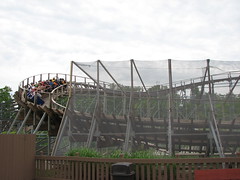 I stand in the middle of the Thanksgiving plaza, the Voyage stands beside me as an impossibly powerful presence, the final switchbacks wrapping over and under track and paths in what one senses is a mathematically perfect pattern, soothing the eye with its rolling oceanic curves, engulfing the midway and yet not haphazardly dominating it. Armed with the knowledge that these curves constitute only the final fifteen seconds or so of a coaster that takes several minutes to complete, looking forward at the impossibly tall lift hill shooting straight up into the heavens before venturing into what is perhaps the most ambitious wooden coaster project ever envisioned, all hidden from sight until the very end, well, that’s just something you have to get in line for.
I stand in the middle of the Thanksgiving plaza, the Voyage stands beside me as an impossibly powerful presence, the final switchbacks wrapping over and under track and paths in what one senses is a mathematically perfect pattern, soothing the eye with its rolling oceanic curves, engulfing the midway and yet not haphazardly dominating it. Armed with the knowledge that these curves constitute only the final fifteen seconds or so of a coaster that takes several minutes to complete, looking forward at the impossibly tall lift hill shooting straight up into the heavens before venturing into what is perhaps the most ambitious wooden coaster project ever envisioned, all hidden from sight until the very end, well, that’s just something you have to get in line for.
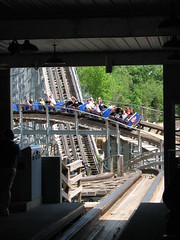 The queue is housed entirely indoors, main bulk of the switchbacks on the lower level of the enormous light blue station house. They’ve included a neat feature whereby one of the final tunnels that runs parallel to the station has a Plexiglas siding so that way people waiting in line can watch as a train suddenly thunders by, one of those neat creative flourishes similar to what was tried with Thunderhead or Troy, but in all honesty I forget that the Voyage even has it because the three, seven car trains run so efficiently that only on a Saturday night might the line ever be long enough that this lower floor is necessary. The queue momentarily leads us back outdoors but still under the roof shelter along a stairway that takes us to the upper level. A recorded voice, soothing and yet in control, prepares us for the ride and then finishes with a quatrain Voyage poem as we enter the loading platform. Plenty of empty floor space to pick whichever row we desire, the back with plenty of extra airtime and intensity, the middle offering greater control and evenly distributed forces, but there’s something about a ride this imposing and majestic that calls us to the front, at least for our first time.
The queue is housed entirely indoors, main bulk of the switchbacks on the lower level of the enormous light blue station house. They’ve included a neat feature whereby one of the final tunnels that runs parallel to the station has a Plexiglas siding so that way people waiting in line can watch as a train suddenly thunders by, one of those neat creative flourishes similar to what was tried with Thunderhead or Troy, but in all honesty I forget that the Voyage even has it because the three, seven car trains run so efficiently that only on a Saturday night might the line ever be long enough that this lower floor is necessary. The queue momentarily leads us back outdoors but still under the roof shelter along a stairway that takes us to the upper level. A recorded voice, soothing and yet in control, prepares us for the ride and then finishes with a quatrain Voyage poem as we enter the loading platform. Plenty of empty floor space to pick whichever row we desire, the back with plenty of extra airtime and intensity, the middle offering greater control and evenly distributed forces, but there’s something about a ride this imposing and majestic that calls us to the front, at least for our first time.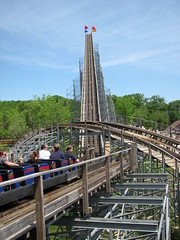
The ride attendants check our belongings for us in a free locker system as we climb into the cars, combining both load time efficiency with security as we don’t have to worry about our stuff getting damaged either on the ride or stolen by guests getting off a different train before we arrive back in the station. The lift appears at first to be along the same line of parallel as the station, but it’s actually angled to the left by several degrees, allowing those looking out from the loading platform to view it straight on as if they’re about to ride, while those on the train waiting to dispatch look at it from oddly off-center. If all trains are running and operations are efficient we might catch fleeting glimpses of another train crisscrossing back and forth underneath the lift hill before suddenly roaring into sight over our heads as one of the switchbacks flies over the stretch on the way to the station. There’s a straight stretch of track out of the station as we slowly approach to greet the lift, before making the quick s-curve dive that causes the skewing of the lift from the station, engaging the base of the chain. The lift is very quick without feeling fast at any particular moment, appearing to allow us the time to think about the ride ahead of us as any conventional chain lift will, but then suddenly finding ourselves at the precipice in about half the time we expected. Curving over the top, there are the first few magnificent airtime hills ahead of us, the return track crossing back and forth along these outward bound hills like it’s a DNA coil, and we look down and realize we can’t see the track all the
appearing to allow us the time to think about the ride ahead of us as any conventional chain lift will, but then suddenly finding ourselves at the precipice in about half the time we expected. Curving over the top, there are the first few magnificent airtime hills ahead of us, the return track crossing back and forth along these outward bound hills like it’s a DNA coil, and we look down and realize we can’t see the track all the 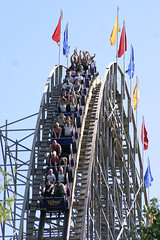 way down the first drop.
way down the first drop.
While it may fall short of El Toro’s record-snatching first drop, the steepness is still number two in the world and at this moment we feel more like we’re on a steel hyper coaster than a wooden coaster. The curvature of the pullover is long enough that we keep on falling at a steeper and steeper angle until reaching the pullout. Don’t expect too much air in the front seat, which is pretty much impossible to achieve on any first drop with the possible exception of Maverick or Griffon (or similar species) but that’s what the back row of a seven car train is for. The speed on the pullout is huge, the foliage surrounding us on all sides turning into a blur of green in our peripheral vision as we stay focused on the track directly ahead. It never once feels rough or like it’s not in control, it’s just a tremendous demonstration of the power carrying us along these rails, as if it could destroy us at any moment if it wanted, but it’s too dignified to ever allow for such a thing.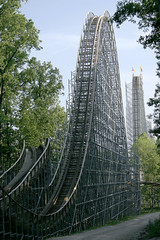
Case in point, the first airtime hill. Long, sustained beautiful floater. If the train were moving too slow this element might not work, but it’s always sailing over the top with nary a loss of speed, the surrounding trees giving a fantastic sense of perspective as we peer over the tops of them at the endless sea of green chlorophyll, and then diving deep underneath them within moments whizzing past the trunks at ground level, the canopy now seemingly a hundred feet above our heads. We surge up again for second sweeping camelback, again slicing over the treetops before naturally falling back down, a slight curve to the right on this one that can hardly be felt. This double repetition of elements is an integral part of understanding how the Voyage’s pacing structure works; short periods of repetition are used throughout the ride to be able to highlight the sudden dynamics contrasts that the Voyage is renowned for, which is not as effective if it were a string of solitary, independent elements one after another, context with other elements before and after the current element is necessary for these dynamic shifts to be apparent.
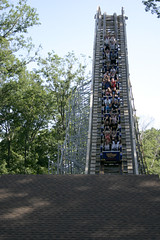 The first major dynamic shift hits riders head on, the narrow maw of a darkened underground tunnel signifying the start of a violent change in pace from the gentle freefall we approach it with. Within seconds of entering the tunnel were are thrust back out, slammed hard up out of our seats and to the left as the train navigates a sharp right turn, plunging back into another underground tunnel without even turning back downhill (it’s carved into the side of a steep hillside), all in about half the time we spent floating out of our seats on just one of the previous airtime hills. In the dark we pull up fast again for a second hill situated between tunnels, this one more rounded with sustained floater (similar to
The first major dynamic shift hits riders head on, the narrow maw of a darkened underground tunnel signifying the start of a violent change in pace from the gentle freefall we approach it with. Within seconds of entering the tunnel were are thrust back out, slammed hard up out of our seats and to the left as the train navigates a sharp right turn, plunging back into another underground tunnel without even turning back downhill (it’s carved into the side of a steep hillside), all in about half the time we spent floating out of our seats on just one of the previous airtime hills. In the dark we pull up fast again for a second hill situated between tunnels, this one more rounded with sustained floater (similar to  the first two camelbacks) than the sudden jolt of a hill that preceded it. Again, notice the repetition with minor variation along this stretch of track. Diving in and out of tunnels between airtime hills is just one of the Voyage’s many creative touches that I think were designed with the enthusiasts in mind, and the fact that these inspired moments continually reoccur throughout the ride with hardly a moment to breathe between them is testament to the Voyage’s status as possibly the best wooden coaster ever built. Back down into a third underground tunnel, the out run is now over and we’re approaching the spaghetti bowl turnaround.
the first two camelbacks) than the sudden jolt of a hill that preceded it. Again, notice the repetition with minor variation along this stretch of track. Diving in and out of tunnels between airtime hills is just one of the Voyage’s many creative touches that I think were designed with the enthusiasts in mind, and the fact that these inspired moments continually reoccur throughout the ride with hardly a moment to breathe between them is testament to the Voyage’s status as possibly the best wooden coaster ever built. Back down into a third underground tunnel, the out run is now over and we’re approaching the spaghetti bowl turnaround.
The first of what will later become many s-curve switchback hills, our cars almost seem to dance as they rock back and forth over and then back downhill in what feels like 4/4 time, to the left, to the right, to the left. We are now officially in the second act of the Voyage, the straight airtime hills of the out run now replaced with an experience that focuses heavily on sustained laterals and changes in direction. This first left turn holds close to the ground while dipping a bit downhill; the speed is sustained and the laterals experienced here are increasingly forceful, a few positives from the inward pitch around the curve but for the most part it’s only a solid push against the right side of our seats that we notice at this moment (as well as the surrounding woodland, this is probably the darkest and most remote moment of the entire coaster during night rides). There’s a quick, anticipatory hop just before finishing this turn, and then the forces let up for just a moment as the train transitions to a slight righthand curve, but instead of rotating the banking in the other direction, we remained tipped to our left, which is now on the outside of the curve. Read an accelerometer while tracking through this maneuver and you’ll notice the laterals are not much stronger in this opposite direction than they were on the left turn before it, but this time the positive g’s that had just been pushing us slightly into our seats are now reversed, causing us to be lifted a bit upward and out of the car. Plus there’s the visual experience of such an element, especially because we’re always so used to turns banking inward, here it just seems so wrong and unnerving to see the opposite.
and changes in direction. This first left turn holds close to the ground while dipping a bit downhill; the speed is sustained and the laterals experienced here are increasingly forceful, a few positives from the inward pitch around the curve but for the most part it’s only a solid push against the right side of our seats that we notice at this moment (as well as the surrounding woodland, this is probably the darkest and most remote moment of the entire coaster during night rides). There’s a quick, anticipatory hop just before finishing this turn, and then the forces let up for just a moment as the train transitions to a slight righthand curve, but instead of rotating the banking in the other direction, we remained tipped to our left, which is now on the outside of the curve. Read an accelerometer while tracking through this maneuver and you’ll notice the laterals are not much stronger in this opposite direction than they were on the left turn before it, but this time the positive g’s that had just been pushing us slightly into our seats are now reversed, causing us to be lifted a bit upward and out of the car. Plus there’s the visual experience of such an element, especially because we’re always so used to turns banking inward, here it just seems so wrong and unnerving to see the opposite.
From one extreme of the banking world (the outward banked turn) in a split moment the train slides right into the other (extreme overbanking). The result of combining this element immediately after the outward banked turn causes them to fit together naturally as one of the most off-kilter S-turns imaginable (recalling the simple back-and-forth dancing that started the turnaround with something much more sinister), and yet it’s an uneven progression because if the outward turn has a strong bite of lateral g-forces, this first 90° banked turn is completely graceful, a quick twist into the turn, bouncing off the inward curvature, the centrifugal force keeping us firmly pressed straight down into our seats before gently twisting back out and down. Just as naturally, the big blue train continues this rotational motion up into the opposite direction one more time for an immediate second 90° banked turn, this one with a bit more of a vertical arch to it (remember, repetition with variation…) It’s almost too pretty and graceful of an element, there being not much in terms of forces or fast direction changes in any direction, but they’re quite impressive just to watch our orientation change so dramatically without being accompanied by any violent dynamics, and it sets up the finale to this part of the ride quite nicely, a very fast-paced, intense s-turn/hop to the right plunging us into a last, quick tunnel. Notice the pattern that we’ve followed since finishing up the fast ground-level turn? S-curve into the outward banked turn to the right, then left with the first 90, right with the second 90, then another left-skewed s-curve? Not that patterns by themselves always mean anything but it’s definitely there as well for anyone that appreciates that sort of thing. The last s-turn/hop is a particularly well-timed touch, being the most rapidly paced element of the coaster thus far and with the quick dive into the tunnel it signals a strong sense of finality to this first half of the ride, such that the lull in the midcourse brake is anticipated rather than simply a break in pace.
before gently twisting back out and down. Just as naturally, the big blue train continues this rotational motion up into the opposite direction one more time for an immediate second 90° banked turn, this one with a bit more of a vertical arch to it (remember, repetition with variation…) It’s almost too pretty and graceful of an element, there being not much in terms of forces or fast direction changes in any direction, but they’re quite impressive just to watch our orientation change so dramatically without being accompanied by any violent dynamics, and it sets up the finale to this part of the ride quite nicely, a very fast-paced, intense s-turn/hop to the right plunging us into a last, quick tunnel. Notice the pattern that we’ve followed since finishing up the fast ground-level turn? S-curve into the outward banked turn to the right, then left with the first 90, right with the second 90, then another left-skewed s-curve? Not that patterns by themselves always mean anything but it’s definitely there as well for anyone that appreciates that sort of thing. The last s-turn/hop is a particularly well-timed touch, being the most rapidly paced element of the coaster thus far and with the quick dive into the tunnel it signals a strong sense of finality to this first half of the ride, such that the lull in the midcourse brake is anticipated rather than simply a break in pace.
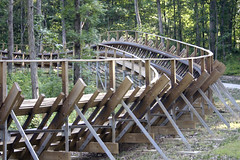 When the ride was first announced and I got my first look at the layout via that NoLimits rendering, I initially strongly disliked the return run. After the triple down it appeared to me as though they ran out of ideas and instead decided to just randomly weave the track back and forth and up and down with an extra 90° thrown in just for the hell of it, all to give the appearance that something was going on when it was really all quite pointless, just trying to get it to line up with the final break run. However, that NoLimits rendering failed to completely do justice to this track, and after watching it being constructed, watching the official POV video when it came out and then riding it for myself, I not only came to realize that not only was the return run just as strong in ideas and craft as the
When the ride was first announced and I got my first look at the layout via that NoLimits rendering, I initially strongly disliked the return run. After the triple down it appeared to me as though they ran out of ideas and instead decided to just randomly weave the track back and forth and up and down with an extra 90° thrown in just for the hell of it, all to give the appearance that something was going on when it was really all quite pointless, just trying to get it to line up with the final break run. However, that NoLimits rendering failed to completely do justice to this track, and after watching it being constructed, watching the official POV video when it came out and then riding it for myself, I not only came to realize that not only was the return run just as strong in ideas and craft as the 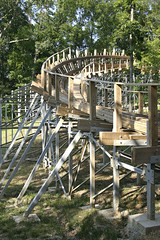 first half of the ride, but it actually is one of the most inspired segments of coaster design anywhere, propelling what had until that point already been a great coaster over the top into something of otherworldly quality. Needless to say, it’s now my favorite part of the ride, and I’ll explain why…
first half of the ride, but it actually is one of the most inspired segments of coaster design anywhere, propelling what had until that point already been a great coaster over the top into something of otherworldly quality. Needless to say, it’s now my favorite part of the ride, and I’ll explain why…
First of all, the level of terrain difference from the top to the bottom is much larger than what it may appear (certainly more so than that NoLimits simulation ever let on), and the pace of the train is in nothing but a crescendo all the way until the end of the ride. Then there’s the layout itself, which begins as a straight forward out-and-back, airtime experience, but with each successive element in a mathematically precise pattern it transforms into an all-out twister layout by the end. Combine this with the aforementioned steady build-up in speed, and the result is nothing short of a modernist reimagining of what only the Beast before it had managed to accomplish (albeit in a decidedly more minimalist, subtle form): a hauntingly psychological ride experience where to understand it means one has to be taken out of the moment where one is normally only cognizant of their immediate experiential sensory inputs, and fit each moment within the context of those both before and after it. While most great coasters finish with some sort of big climatic finale, on the Voyage there is no need, because the steady, relentless crescendo becomes far more effective of a finale than any individual, momentary element could ever dream of being. But let’s look at this 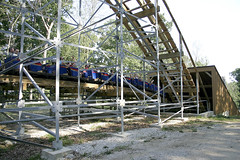 section of track piece-by-piece to see exactly how it accomplishes this.
section of track piece-by-piece to see exactly how it accomplishes this.
The train rolls off the brake run and straight into the mouth of yet another tunnel. While the underground triple down is arguably the Voyage’s most defining and original element, monitor the average rider’s emotional response to this moment and it might not be what we’d expect from such an element? Is it excitement or, depending on one’s disposition, possibly terror, as is normally the standard emotional response to a coaster as bold and consistently thrilling as the Voyage? Surprisingly, no. Remember, the entire first half of the layout until the midcourse brake run is by itself structured in a way identical to most well-conceived standard coasters, and so we begin this moment in a state of catharsis (by this point the slow entry into yet another tunnel has become something safe and familiar in the ride). Therefore the natural response to this next drop into a tunnel is one of joy, amusement, maybe even laughter.
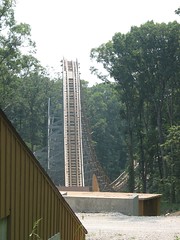 Some people have pointed out that as crazy an element as the triple down may come across as an idea, in actuality it’s not intense at all. In this they are factually correct, but the implication is usually that this is somehow a bad thing, to which I must fully disagree. If it were otherwise then that particular emotional response would not be feasible for many people and the ride might run the risk of becoming monotonous. Here is an opportunity to hoot, holler, enjoy the floater air over each successive dip and just be taken in by the pure visceral oddity of this track, being completely enclosed and yet diving further underground in a stop-start motion not once, nor twice, but three times before finally emerging at (surprise!) ground level.
Some people have pointed out that as crazy an element as the triple down may come across as an idea, in actuality it’s not intense at all. In this they are factually correct, but the implication is usually that this is somehow a bad thing, to which I must fully disagree. If it were otherwise then that particular emotional response would not be feasible for many people and the ride might run the risk of becoming monotonous. Here is an opportunity to hoot, holler, enjoy the floater air over each successive dip and just be taken in by the pure visceral oddity of this track, being completely enclosed and yet diving further underground in a stop-start motion not once, nor twice, but three times before finally emerging at (surprise!) ground level.
Furthermore, isn’t this comfortably pleasurable reaction exactly not the emotional response one would expect to have at this point in the ride? Especially as it picks up speed and a bit of an edge on the crest of the third subterraneous drop, one might also feel a fleeting sensation of discomfort precisely because of their relative comfort. “This isn’t how I should be feeling at this point in the ride; we’ve just dipped  underground three times in a row and have got a fairly strong pace back and yet I was grinning at it all.” The German philosopher Arthur Schopenhauer said something to the effect that there is no such thing as real happiness, the only thing humans are capable of feeling is pain, and happiness is only created to the degree that there is a lack of pain. While we needn’t be as pessimistic as Schopenhauer (at least for the sake of this ride analysis), we will soon find that a somewhat similar concept can be applied to the Voyage: it is through this moment of ‘happiness’ at the midpoint that the white-knuckle intensity that eventually emerges throughout the last portion of the ride can be contextualized against, and accordingly vice versa with the relief felt during this moment that otherwise wouldn’t exist in isolation.
underground three times in a row and have got a fairly strong pace back and yet I was grinning at it all.” The German philosopher Arthur Schopenhauer said something to the effect that there is no such thing as real happiness, the only thing humans are capable of feeling is pain, and happiness is only created to the degree that there is a lack of pain. While we needn’t be as pessimistic as Schopenhauer (at least for the sake of this ride analysis), we will soon find that a somewhat similar concept can be applied to the Voyage: it is through this moment of ‘happiness’ at the midpoint that the white-knuckle intensity that eventually emerges throughout the last portion of the ride can be contextualized against, and accordingly vice versa with the relief felt during this moment that otherwise wouldn’t exist in isolation.
Emerging from the tunnel, we begin that logically precise sequencing that builds all the way to the finale.
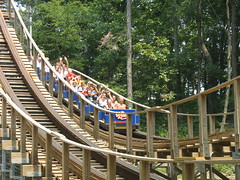 First, a perfectly linear bunny hop. What should be the physical sensation? A light floater/ejector mix, pushing our derrieres up out of the seat but never forcing it into the top of the lapbar. What is the emotional response? Same as it was in the tunnel, simple, joyous fun. In fact it’s perhaps my favorite single spot of airtime out of the ride’s 24.2 seconds worth of that intangible substance.
First, a perfectly linear bunny hop. What should be the physical sensation? A light floater/ejector mix, pushing our derrieres up out of the seat but never forcing it into the top of the lapbar. What is the emotional response? Same as it was in the tunnel, simple, joyous fun. In fact it’s perhaps my favorite single spot of airtime out of the ride’s 24.2 seconds worth of that intangible substance.
Second, another bunny hop. This one is mostly identical to the first (repetition) but has a slight righthand curvature to it as it follows alongside the second camelback hill. We feel some of the airtime transferred into laterals although the mix is still pretty even. We’re still having fun, but the turn catches us a bit off-guard and we have to brace for it slightly instead of simply enjoying the airtime.
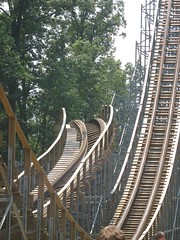 Third, this hill has a similar profile as the previous, but adds on to it with a tighter curve to the left and then switches back to the right after it crests. Airtime is even less pronounced but for the first time since the turnaround we’re starting to feel some real direction changes (achieved by combining rotational motion with the lateral forces) rather than the few light laterals along an otherwise forward-moving stretch of track as the previous hill.
Third, this hill has a similar profile as the previous, but adds on to it with a tighter curve to the left and then switches back to the right after it crests. Airtime is even less pronounced but for the first time since the turnaround we’re starting to feel some real direction changes (achieved by combining rotational motion with the lateral forces) rather than the few light laterals along an otherwise forward-moving stretch of track as the previous hill.
Fourth, rather than a flat, drawn-out pullout between the next element there’s a bit of a tricky ‘slalom’ effect as the track tips slightly to the left before continuously banking back up to the right again. The perceived timing between elements is subsequently shortened because of this distraction, also due to the steadily increasing speed. The train scoots back up to the right in a harsher, more jolting motion than anything else experienced along the return run so far. There’s a quick burst of airtime over the top, but rather than be the ‘bring a smile to your face’ fun variety, here it’s more subversive and cutting, caused partly by the faster timing and strength over the top and also by the sharper transitions into the curves at either end. The track reverses directions once again on the leadout and now starts to curve left again.
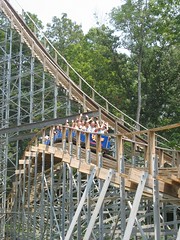 Fifth, real laterals akin to those on the turnaround have now fully developed and any pretense that this return run is about airtime has now been dropped. There’s a brief hill over this turn that the train scurries over, any potential for airtime is instead transferred into even stronger laterals (generally laterals accompanied with reduced gravity will feel stronger than those without because our entire weight is then pressed against the side of the seat instead of shared between the side and bottom as we would on a curve at the bottom of a dip). This is repeated a second time taking us even farther uphill.
Fifth, real laterals akin to those on the turnaround have now fully developed and any pretense that this return run is about airtime has now been dropped. There’s a brief hill over this turn that the train scurries over, any potential for airtime is instead transferred into even stronger laterals (generally laterals accompanied with reduced gravity will feel stronger than those without because our entire weight is then pressed against the side of the seat instead of shared between the side and bottom as we would on a curve at the bottom of a dip). This is repeated a second time taking us even farther uphill.
Sixth, there is a slight pause in force as the transition back from left to right again takes place. There is a minor downhill ‘skip’ (as I recall this was much more violent in its opening year and they have since then smoothed this dip out much more) and the train suddenly flips us through 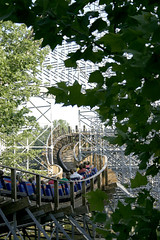 a hard right around our axis so we’re completely parallel to the ground. Within the back-and-forth sequencing of the curves, this moment will stand out not only from the extreme 90° banking but because it is the only one to feature very strong rotational forces (first spinning to the right entry and then the left on the exit with a momentary push of positives in the middle) while containing no laterals. As we will later see, it comes at a strategically important location along the sequence as well.
a hard right around our axis so we’re completely parallel to the ground. Within the back-and-forth sequencing of the curves, this moment will stand out not only from the extreme 90° banking but because it is the only one to feature very strong rotational forces (first spinning to the right entry and then the left on the exit with a momentary push of positives in the middle) while containing no laterals. As we will later see, it comes at a strategically important location along the sequence as well.
Seventh, the train tips to the left a bit as it slowly curves back down to ground level. The left curvature is fairly consistent all the way to the next switchback, but the laterals are much harsher at the beginning and end of this curve (owing to the minor rise in the middle that correspondingly increases the banking slightly) so in effect this feels a bit more like two left turns plugged back-to-back rather than one continuous turn. One thing that should be pointed out is that up until the 90° banked turn, the timing between elements has been set at a rhythmically steady rate, almost hypnotic, except for it also increases in timing quickness. This builds up to the double leftward skip just before the 90° turn, but then coming immediately out of the turn the timing seems to slow down again around this left turn. This is ironic because the train is now traveling at its fastest since low left ground turn on the turnaround. Coincidentally this curve does ‘recall’ that section of the far turnaround quite well, both being laterally-steady left curves that break the established pace of the timing between moments for a brief second, and then suddenly jolting alive again with a couple tight maneuvers as it races towards the climax. While the return run is decidedly more minimalist and repetitive than the original out run with its big, dramatic elemental flourishes, this moment for me always subconsciously recalls a similar point in the progression structure of the first half and thus helps set up the actual finale much better.
out of the turn the timing seems to slow down again around this left turn. This is ironic because the train is now traveling at its fastest since low left ground turn on the turnaround. Coincidentally this curve does ‘recall’ that section of the far turnaround quite well, both being laterally-steady left curves that break the established pace of the timing between moments for a brief second, and then suddenly jolting alive again with a couple tight maneuvers as it races towards the climax. While the return run is decidedly more minimalist and repetitive than the original out run with its big, dramatic elemental flourishes, this moment for me always subconsciously recalls a similar point in the progression structure of the first half and thus helps set up the actual finale much better.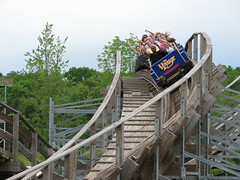
Eighth, huge rotation back to the right over the top of this hill, everyone but the most staid of enthusiasts are by now arms down and holding on tight. The banking really throws us far on our sides but the intensity on the way down is still just as intense. Although it has been a constant evolution in the progression of the return run elements from gentle out-and-back into intense twister, this moment is when the ride definitively abandons the ‘forward momentum over hills’ sense of movement through space that makes up the out-and-back experience, and completely replaces it with the ‘angular velocity changes around curves’ mindset that makes up any good twister layout.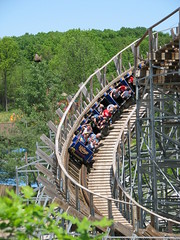
Ninth, we dive into a tunnel before immediately bursting back out a split second later, recalling the first half’s rapid-fire underground excursions. The next element is basically a mirrored recapitulation of the previous s-turn hill, only the intensity and degree of the banking rotation over the top are even more embellished. The way back down to the left can almost feel like another 90° turn for a moment, and instead of following it up with another evolution of the previous element it instead just continues to hammer the riders as the left curve continues around a full 180° and through another tunnel, extremely brief, never letting the adrenaline slip for even a second. A quick pop up out of the tunnel producing a split-second of floater before slamming hard to the right again around another steeply banked but still laterally-intense turn, the sense of finality to the entire ride is strong with these last sustained moments, but it never wants to give in, just not quite yet. Again, it holds this force for a couple moments as it skips along a curving double-up, hitting the brakes hard without a single superfluous moment added after this incredible climax.
Look again at the pattern of this finale and we’ll see that my initial assessment that it appeared ‘random-looking’ is in fact the exact opposite case. Here “R” stands for a right turn, “L” for a left, and the first … represents the straight hill while the later ellipses represent the sustained curving used in the ride’s finale.
… R-L-R-R-L-L-R90-L-L-R-R-L… R……
The structure is at once perfectly balanced, a progression pattern of rights and lefts emerging in both the first and second half with the singular 90° turn acting as the centerpiece, with each half also a mirror of each other. At the same time, there’s also a linear progression to the return run, with the tightening timing and slowly increasing pace and intensity as the layout works its way back down the nearly 100 ft. elevation difference downhill. So masterfully has each moment precluded each other in a progression structure designed to achieve perfectly balanced drama, that by the time the ride is over and the train has come to its final rest, riders are once again put in that elevated cathartic state. This is particularly notable because, as I mentioned earlier, this is actually the second time along the course of the ride that this happens; few coasters out there are able to progress with the structural discipline needed to achieve even one. However, while the first catharsis experienced along the midcourse brake run results in something fun and innocent, after the hauntingly mesmerizing buildup to the second climax, this second ‘actual’ catharsis is of a distinctly more noble flavor. One is left not in a state of relief, but in awe. The Voyage is complete, nothing more can possibly be added to it, but instead of being completely let off of the emotional hook it uses to pull riders into the experience as is the standard with most states of catharsis, it will continue to linger with one for several moments, minutes, hours, days, weeks, years, maybe even an entire lifetime. Each second of the ride transcends category as they unite to form a whole so perfect that to remove one single moment will cause the entire experience to collapse. So completely fulfilling and life-enriching is a ride on the Voyage that I’m reminded of what the ancient Greeks would call out to a gladiator achieving their ultimate victory: “Die now! Die now! You will never be as happy again!” While a truly great ride on the Voyage (at night in the pitch blackness after a summer rainfall has greased the rails) could conceivably warrant a similar reaction as the ancient Greeks would have, we needn’t worry ourselves about our preferred method of suicide once we disembark from the loading platform because of one key difference:
We can ride it again. Shall we?
I stand in the middle of the Thanksgiving plaza, the Voyage’s finale wrapping all around us, sort of suffocating the atmosphere by closing in on all sides, the banked turns nearly all facing outward from the midway and the brake run being a huge black mark slapped over and across what still might have been a pleasant, oceanic painting of coaster track. Compelled forward to escape this negative space, I’m drawn to the ride’s entrance, not before watching a train rush by, and as I watch my subconscious tells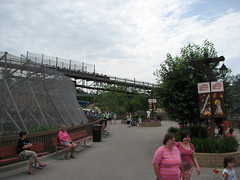 me that while most of the coaster remains out of view, the ending has now been given away, and knowing precisely how the ride will inevitably finish removes much of the mystery of the attraction, compared to the reverse situation of the Raven, where even the comfort of knowing how the first half of the ride might behave by having seen it from the parking lot doesn’t remove the suspense of not being able to see the finale for one’s own eyes until they’re actually riding it in person.
me that while most of the coaster remains out of view, the ending has now been given away, and knowing precisely how the ride will inevitably finish removes much of the mystery of the attraction, compared to the reverse situation of the Raven, where even the comfort of knowing how the first half of the ride might behave by having seen it from the parking lot doesn’t remove the suspense of not being able to see the finale for one’s own eyes until they’re actually riding it in person.
The station is not much more than a gigantic, sky-blue pentagon box, aesthetically flat and vacant, while also creating a sense of negative space as one realizes their relation of being outside of the box rather than welcomed into it. The queue entry point is a very narrow, unassuming pathway that frequently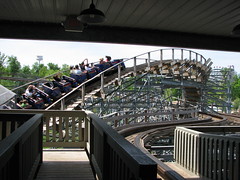 bottlenecks whenever a group of patrons coming from the rest of the park for their first ride meets another group of riders coming around from the gift shop to do it again. Thankfully we needn’t use the lower floor of queuing area on this occasion, a claustrophobic space with railings set maybe three feet apart and stagnant air trapped inside properly reminding one of being locked up in the ship’s bilge. There are some attempts at providing a nautical atmosphere, but ‘attempts’ is all they can be described as, since they consist of only identical ship wheels and nets nailed against the walls at haphazard angles (sort of like a middle-schooler forgetting to do a class project until the morning of its due date, and the presentation they cobble together on the way to the bus doesn’t actually have any value in and of itself but is just there to prove that they did at least remember it).
bottlenecks whenever a group of patrons coming from the rest of the park for their first ride meets another group of riders coming around from the gift shop to do it again. Thankfully we needn’t use the lower floor of queuing area on this occasion, a claustrophobic space with railings set maybe three feet apart and stagnant air trapped inside properly reminding one of being locked up in the ship’s bilge. There are some attempts at providing a nautical atmosphere, but ‘attempts’ is all they can be described as, since they consist of only identical ship wheels and nets nailed against the walls at haphazard angles (sort of like a middle-schooler forgetting to do a class project until the morning of its due date, and the presentation they cobble together on the way to the bus doesn’t actually have any value in and of itself but is just there to prove that they did at least remember it).
The loading platform is functional but the loading gates for the individual rows don’t extend very hard so it can at times be hard to tell exactly which seat you’re queuing for until a cycle or two before your ride. On my date of visit they only had one train running all day, although thankfully the crowds were still so light that there were walk-ons for most of the morning, but it eventually did swell to nearly a half hour later in the afternoon before everyone abandoned the area in the last two hours before the park closed (more details on that in the Holiday World article). I think part of the reason for this was the platform attendants were still in training, although given how long the ride time is I have to wonder how big of a difference that should make at all, especially since it’s designed to run three. Actually, I think they only ever run two at a time any more except for on the busiest days, because the third train only shaves a few seconds of wait time off for everyone and spends the rest of its time stacked on the brake run; the first night I rode it back in 2006 was the only time I ever saw all three trains on the track, and they frequently had all three stacked up. Not that I want to put fault on anyone specifically for personal lack of effort, but this has always been one of those reasons that made me completely perplexed by the park’s continual win of the best employees award in the Golden Tickets for every year (they finally lost to Silver Dollar City in the 2009 poll). Correct me if I’m wrong but Knott’s Ghostrider runs with the same train configurations (three seven-car PTCs) and I don’t recall anything about stacking being a problem with them, and they even have a shorter ride length.
 I think this problem will be completely resolved starting in 2010 with the replacement of the new Timberliner trains; the fact that they’re only replacing them with two and this is still going to improve capacity by a considerable margin is sadly indicative of how ineffective the three PTCs were. I personally am not sad to see them go because the seatbelts on those always bothered me (having the buckle located directly between the crotch and lapbar isn’t a good idea on a coaster touted as having the most airtime in the world), plus the hollow seat dividers were awful. In 2006 when the coaster was really hauling ass around the course, those seat dividers were the one single thing about the
I think this problem will be completely resolved starting in 2010 with the replacement of the new Timberliner trains; the fact that they’re only replacing them with two and this is still going to improve capacity by a considerable margin is sadly indicative of how ineffective the three PTCs were. I personally am not sad to see them go because the seatbelts on those always bothered me (having the buckle located directly between the crotch and lapbar isn’t a good idea on a coaster touted as having the most airtime in the world), plus the hollow seat dividers were awful. In 2006 when the coaster was really hauling ass around the course, those seat dividers were the one single thing about the 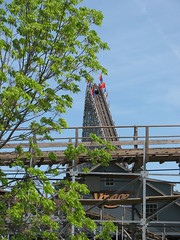 entire ride that managed to nearly ruin it for me. The laterals were so strong and not having a solid edge to slide against created pressure points on the side of my leg, I felt like it wasn’t until later in the day that I could finally start to enjoy what the ride was supposed to be like. This year it was running as such that those pressure points weren’t a problem anymore, but sadly I realized it was only for the wrong reasons.
entire ride that managed to nearly ruin it for me. The laterals were so strong and not having a solid edge to slide against created pressure points on the side of my leg, I felt like it wasn’t until later in the day that I could finally start to enjoy what the ride was supposed to be like. This year it was running as such that those pressure points weren’t a problem anymore, but sadly I realized it was only for the wrong reasons.
But now buckled and locked in, I have to say that I am really anticipating this ride. Who wouldn’t, it’s rated #1 in the world, and one look at the overhead layout renderings will easily reveal why. No other roller coaster has ever been built at such an epic scale while at the same time making sure every moment is original and designed specifically with coaster enthusiasts in mind. Raven and Legend, which are my frame of reference so far for the day, are both puny compared to the Voyage, and the mind reels at the prospect of just how much more amazing this ride is going to be than both of those already stellar examples of wooden coasters.
 It doesn’t pretend to be an epic roller coaster experience, however. Unlike the Beast or others where there’s a long, formalized process designed to slowly give away information while keeping most of its hand hidden in a way to help build anticipation, on the Voyage the train rolls right out of the station to directly confront the lift, which very quickly whisks us to the top of the 163 foot tall ascent as if it were only 63 feet. Even the Raven lets it simmer for a bit longer with the long prelift section and a comparatively slow lift hill. I guess on days with one-train operation it helps reduce the waiting, but I feel like this approach harms what could be a tremendous psychological impact.
It doesn’t pretend to be an epic roller coaster experience, however. Unlike the Beast or others where there’s a long, formalized process designed to slowly give away information while keeping most of its hand hidden in a way to help build anticipation, on the Voyage the train rolls right out of the station to directly confront the lift, which very quickly whisks us to the top of the 163 foot tall ascent as if it were only 63 feet. Even the Raven lets it simmer for a bit longer with the long prelift section and a comparatively slow lift hill. I guess on days with one-train operation it helps reduce the waiting, but I feel like this approach harms what could be a tremendous psychological impact.
Cresting the top, the first drop is supposed to be one of those showstoppers that everyone talks about as being one of the most extreme parts of the ride: 154 feet at 66°, admittedly beaten by the Intamin plug-n-play’s capabilities but for traditional tracked wooden coasters this is still supposed to be the best in the world. Except it isn’t. In fact, of the three first drops located within the same park, I personally would rate this one the lowest. Apparently sometime during their transition from CCI to the Gravity Group, the designers decided the best way to improve on their first drops was to design them more like B&M do, with a gently rounded parabola over the entire crest rather than the tight snap over the top followed by a long flat ramp until the pullout. A friend of mine who has not been on any of these coasters (he doesn’t need to since he can always figure out exactly how they will feel just by using online resources) has insisted that this method represents a huge improvement over the old CCI method because the flat track in the middle was just wasted opportunity for more airtime, and explained all the physical principles that made it so. He’s forgetting to look at it from the inverse perspective: making the first drop continuously rounded means they have to make the curvature over the top much wider, and it takes longer to reach the maximum steepness. As a result, the rotational motion forward over the drop is much softer, and it actually feels shallower than the first drops on Raven or Legend. While those rides whip you over and make you immediately aware of the sudden change of movement through space (which is sustained on the flat ramp with the constant acceleration removed of any other interfering dynamics) on the Voyage you just float down until you’re at the bottom.
the designers decided the best way to improve on their first drops was to design them more like B&M do, with a gently rounded parabola over the entire crest rather than the tight snap over the top followed by a long flat ramp until the pullout. A friend of mine who has not been on any of these coasters (he doesn’t need to since he can always figure out exactly how they will feel just by using online resources) has insisted that this method represents a huge improvement over the old CCI method because the flat track in the middle was just wasted opportunity for more airtime, and explained all the physical principles that made it so. He’s forgetting to look at it from the inverse perspective: making the first drop continuously rounded means they have to make the curvature over the top much wider, and it takes longer to reach the maximum steepness. As a result, the rotational motion forward over the drop is much softer, and it actually feels shallower than the first drops on Raven or Legend. While those rides whip you over and make you immediately aware of the sudden change of movement through space (which is sustained on the flat ramp with the constant acceleration removed of any other interfering dynamics) on the Voyage you just float down until you’re at the bottom.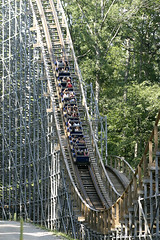
The sense of speed is not as great as I might have hoped for either. The only thing that gives it away is the fact that the surrounding field of bright green grass becomes something of a blur, but even then the trees have been cut back far enough that it’s hard to observe any rapid parallax while still looking straight forward, and the curvature still follows the same path any B&M speed coaster would so there’s not much in the forces or dynamics to really impress me with the scale or power. This opening act was clearly inspired by Shivering Timbers and even tried to improve on it with the added height and speed and more rounded hills that would in theory produce more airtime, but comparing my experiences with each opening act (probably some 40 rides on the Voyage, including 15 or so consecutive re-rides in the front and back seat on my last visit, versus exactly 199 rides on Shivering Timbers since 1998) Shivering Timbers is the superior coaster. It’s even more than thirty feet shorter, but if I didn’t know better and just based my opinion on my immediate visceral reaction to them both, I’d swear Shivering Timbers was the taller and faster of the two.
 But the airtime is better, right? Logically it ought to be since it’s been touting the label of the world’s best airtime coaster since it opened with “24.2 seconds” worth, but even in this regard the Voyage somehow comes up short. The hill is wide and the airtime sustained, but it’s neither that strong or that long to make it anything remarkable, and the wide radius over the top robs it of the more interesting dynamics founds on the taller, narrower hills found on Shivering Timbers. The goal was to sustain -.2 g’s or something like that, just like a B&M speed coaster, which seems like it could be a good goal (at least if you ask people that aren’t me) but it doesn’t translate well to a wooden coaster. While the ride is smooth, there’s still enough jostling that the perfect floater sensation easily becomes contaminated with a lot of ‘noise’, and the individual ratcheting lapbars aren’t as well designed to experience this sort of air (if it had the same trains
But the airtime is better, right? Logically it ought to be since it’s been touting the label of the world’s best airtime coaster since it opened with “24.2 seconds” worth, but even in this regard the Voyage somehow comes up short. The hill is wide and the airtime sustained, but it’s neither that strong or that long to make it anything remarkable, and the wide radius over the top robs it of the more interesting dynamics founds on the taller, narrower hills found on Shivering Timbers. The goal was to sustain -.2 g’s or something like that, just like a B&M speed coaster, which seems like it could be a good goal (at least if you ask people that aren’t me) but it doesn’t translate well to a wooden coaster. While the ride is smooth, there’s still enough jostling that the perfect floater sensation easily becomes contaminated with a lot of ‘noise’, and the individual ratcheting lapbars aren’t as well designed to experience this sort of air (if it had the same trains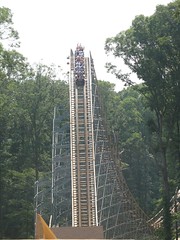 as the Phoenix then I’d be writing something different here, but as it happens, it doesn’t). It pulls back up and heads into the second camelback hill, this one with a slight curvature in it. It doesn’t add anything to the experience, and in fact because it is banked inward it actually detracts from the airtime even more (the laterals start to translate into the positives… when I did a similar beginning in Quiver I recognized this problem and designed the curved camelback to bank outward instead of inward, which actually works better at both reducing laterals while sustaining the zero or negative-G environment.)
as the Phoenix then I’d be writing something different here, but as it happens, it doesn’t). It pulls back up and heads into the second camelback hill, this one with a slight curvature in it. It doesn’t add anything to the experience, and in fact because it is banked inward it actually detracts from the airtime even more (the laterals start to translate into the positives… when I did a similar beginning in Quiver I recognized this problem and designed the curved camelback to bank outward instead of inward, which actually works better at both reducing laterals while sustaining the zero or negative-G environment.)
So this opening act to the ride fell short from the original inspiration point. That’s not necessarily a crippling problem in my book, since this ride goes on to draw inspiration from many more unique sources, and it’s all about the quality of the overall layout rather than the immediate sensorial feedback that makes a great ride, correct? After getting the opening act of Shivering Timbers, the next coaster the Voyage decides to ape from is Idaho’s Tremors with the airtime hills diving in and out of tunnels. Again, the Voyage might appear to one-up Tremors by having two hills in a row diving between three tunnels, rather than just one hill between two tunnels, and while I’ve not been on Tremors yet to make any definitive judgments, I’ve again got to say that Tremors did it better. The thing that so strongly appeals about this ‘diving in and out of tunnels’ technique, besides just being a cool idea, is that the integration of the tunnels in what would otherwise be basic bunny hops gives the ride a sense of rhythm, as it were. From the POVs, I can feel that rhythm on Tremors, the ‘dark-air-dark’ sequencing all being well-proportioned with respect to one another and creates a forceful impression on the psyche. Meanwhile the Voyage is trying to go uphill while also fit into the same tunnels the return run, and as a result the effect is lost due to an oddly-timed, uneven sequence pattern. First of all the tunnels are much shallower and shorter so they already don’t make as  much of an impact, and then the hill between these first two is so shallow and fast that it doesn’t even register as a hill, just a small break between what should have been one continuous tunnel. In fact it’s not even a hill, only part of a double-up as the layout tries to navigate uphill. That might be a decent approach, it makes the timing really fast and out-of-control, but then it follows up with the next hill, which is so much wider and taller (and frequently failing to produce any discernible airtime, sort of like the Legend’s failed 5th drop) that the contrast is not only wholly uneven, but by the time we get to the third tunnel my mind has already moved on to the turnaround, which was laid out clear in front of me when we crested the previous hill.
much of an impact, and then the hill between these first two is so shallow and fast that it doesn’t even register as a hill, just a small break between what should have been one continuous tunnel. In fact it’s not even a hill, only part of a double-up as the layout tries to navigate uphill. That might be a decent approach, it makes the timing really fast and out-of-control, but then it follows up with the next hill, which is so much wider and taller (and frequently failing to produce any discernible airtime, sort of like the Legend’s failed 5th drop) that the contrast is not only wholly uneven, but by the time we get to the third tunnel my mind has already moved on to the turnaround, which was laid out clear in front of me when we crested the previous hill.
 So now the Voyage becomes a fast, ground-level terrain coaster, this time most likely inspired by their own Raven. Except again for the third time the Voyage falls short from the original point of inspiration. This time it’s primarily because of the setting. The whole point of having a ground-level terrain coaster is supposed to be the sense of mystery and suspense, that you can’t see what’s around the next corner and are just blindly charging forward through the trees with reckless abandon. But as I already mentioned, I got a clear view of this entire turnaround when I crested the previous hill, so many trees around the area have been removed. It wasn’t a clear-cut deforestation as you’d get at a Cedar Fair park (this is Holiday World, after all), but coming from the same people that built the Raven’s finale and especially given how far out in the woods we are I’d have expected better terrain preservation at this point in the ride, when instead it still feels like we’ve not ventured too far from the safety of Holiday World’s green, pastoral fields.
So now the Voyage becomes a fast, ground-level terrain coaster, this time most likely inspired by their own Raven. Except again for the third time the Voyage falls short from the original point of inspiration. This time it’s primarily because of the setting. The whole point of having a ground-level terrain coaster is supposed to be the sense of mystery and suspense, that you can’t see what’s around the next corner and are just blindly charging forward through the trees with reckless abandon. But as I already mentioned, I got a clear view of this entire turnaround when I crested the previous hill, so many trees around the area have been removed. It wasn’t a clear-cut deforestation as you’d get at a Cedar Fair park (this is Holiday World, after all), but coming from the same people that built the Raven’s finale and especially given how far out in the woods we are I’d have expected better terrain preservation at this point in the ride, when instead it still feels like we’ve not ventured too far from the safety of Holiday World’s green, pastoral fields.
In fact, it’s sometime around going over the first s-curve hill that my experience with the Voyage starts to turn negative, not because of anything the ride itself is explicitly doing wrong, but because I’m put in a state of cognitive dissonance. That is, the reality does not see eye-to-eye with my expectations, and I experience displeasure as my mind tries to sort out this contradiction. Before riding I was able to logically conclude that the Voyage was several tiers above all other wooden coasters in terms of grandeur of scope and just overall quality, and that is true; any coaster that starts out like Shivering Timbers, switches to Tremors and then finishes with the Raven’s finale in just the first half of the ride should automatically be considered superior to those examples. The problem is I realize that I was only looking at the Voyage from the Hegelian idealist perspective, and now that I’m actually sitting a couple feet above the rails riding it for myself, I’m now looking at the coaster from the existentialist perspective where those overarching visions of what the ride should be come secondary to what my own personal experience right now is, and frankly it’s quite underwhelming.
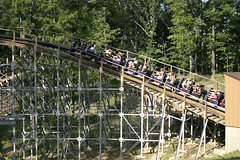 Due to the large height difference in the terrain, the scale of the elements have now been reduced to be even smaller than what’s found on the park’s other coasters, never venturing more than 25 feet above the ground (but also lacking the proper use of the forest that would make such low-to-the-ground tactics pay off). As a result I’m thinking, “both the Raven and Legend were much better and more impressive at this point in the ride, where I had either the final s-curves through the trees or the giant carousel helix, while this is just relatively small, indeterminate, and sort of a nothing experience compared to those other two”. It starts out trying to be aggressive with some strong sustained laterals, although unlike the Raven or especially the Legend’s turns which have real
Due to the large height difference in the terrain, the scale of the elements have now been reduced to be even smaller than what’s found on the park’s other coasters, never venturing more than 25 feet above the ground (but also lacking the proper use of the forest that would make such low-to-the-ground tactics pay off). As a result I’m thinking, “both the Raven and Legend were much better and more impressive at this point in the ride, where I had either the final s-curves through the trees or the giant carousel helix, while this is just relatively small, indeterminate, and sort of a nothing experience compared to those other two”. It starts out trying to be aggressive with some strong sustained laterals, although unlike the Raven or especially the Legend’s turns which have real 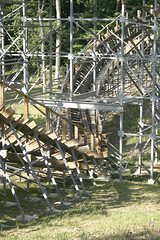 bite to them, on the Voyage even if the absolute forces are as strong or stronger than those two, the illusion of being out of control is given away by Gravity Group’s constantly shifting banking pitches clearly controlled by a computer, consequently lacking the emotional connection the earlier examples had and all I can do is just say to myself, “look, they remembered to put laterals in, and the teleological part of the enthusiast brain tells me that my enjoyment of the ride can be defined by appreciating the designers’ ability to maximize the quantity output of forces at any random moment”. But then it gives up on that experience all together and switches to the back-to-back 90 degree turns, which are surprisingly bland and undynamic, and are there more to satisfy the designers’ egos. The quick double-hop down into a tunnel injects a bit of authentic intensity into the layout before subduing again on the midcourse block brake.
bite to them, on the Voyage even if the absolute forces are as strong or stronger than those two, the illusion of being out of control is given away by Gravity Group’s constantly shifting banking pitches clearly controlled by a computer, consequently lacking the emotional connection the earlier examples had and all I can do is just say to myself, “look, they remembered to put laterals in, and the teleological part of the enthusiast brain tells me that my enjoyment of the ride can be defined by appreciating the designers’ ability to maximize the quantity output of forces at any random moment”. But then it gives up on that experience all together and switches to the back-to-back 90 degree turns, which are surprisingly bland and undynamic, and are there more to satisfy the designers’ egos. The quick double-hop down into a tunnel injects a bit of authentic intensity into the layout before subduing again on the midcourse block brake.
While we have this brief pause in the ride action, let’s step back for a moment and analyze just what sort of quality experience we’re getting on a moment-by-moment basis. As I mentioned earlier, both the profiling of the hills (evidenced especially in the first three drops) and the variations in the banking pitches suggest a very high degree of computer control more similar to any modern steel coaster than an authentic wood experience. The airtime is all incredibly weak and controlled, shaped more like B&M’s long floater hills than the harsh, circular curvatures found on other wooden coasters. In fact, where is that record 24.2 seconds of airtime? I count very few locations along the layout where it could be found at all. The first two camelbacks get several seconds worth in, and the first drop but only if you’re in the back 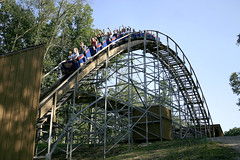 (and I already criticized why the forces here are of sub-par quality), after that there’s the second hill between the tunnels, which frequently runs too slow so there isn’t any uplift anyway. The few other moments are also incredibly weak and laced with much stronger laterals that completely overpower any sensations of weightlessness. On the way back there’s only a light tickle on the third drop of the triple down and then the first camelback on the return run. Everything else after that is just laterals. Honestly, for being the so-called ‘world record holder for most airtime’, the Voyage probably isn’t even in my top twenty list of wooden coasters I’d recommend to people if they just want to experience airtime (available on request).
(and I already criticized why the forces here are of sub-par quality), after that there’s the second hill between the tunnels, which frequently runs too slow so there isn’t any uplift anyway. The few other moments are also incredibly weak and laced with much stronger laterals that completely overpower any sensations of weightlessness. On the way back there’s only a light tickle on the third drop of the triple down and then the first camelback on the return run. Everything else after that is just laterals. Honestly, for being the so-called ‘world record holder for most airtime’, the Voyage probably isn’t even in my top twenty list of wooden coasters I’d recommend to people if they just want to experience airtime (available on request).
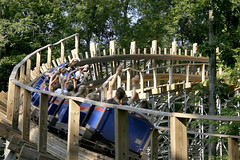 But while it may be relatively weak on the negative-g scale, there’s no way anyone could argue that the Voyage isn’t one of the most intense roller coasters built in recent years. However, ‘intensity’ has become a tricky thing to define in recent years. Most people seem to have noticed that rides they would describe as ‘intense’ can be analyzed to produce higher than normal g-forces, and generally these forces switch intensity in relatively short durations of time. And so when designing a new coaster, if they want it to be ‘intense’ these are the only factors they deem necessary to focus on. The Voyage sustains very high lateral g-forces at all moments, and the transition times are very fast so there are not lulls between them. And yet when contrasting with other rides that utilize
But while it may be relatively weak on the negative-g scale, there’s no way anyone could argue that the Voyage isn’t one of the most intense roller coasters built in recent years. However, ‘intensity’ has become a tricky thing to define in recent years. Most people seem to have noticed that rides they would describe as ‘intense’ can be analyzed to produce higher than normal g-forces, and generally these forces switch intensity in relatively short durations of time. And so when designing a new coaster, if they want it to be ‘intense’ these are the only factors they deem necessary to focus on. The Voyage sustains very high lateral g-forces at all moments, and the transition times are very fast so there are not lulls between them. And yet when contrasting with other rides that utilize  ‘intensity’ as a positive factor in their overall experience, I find the Voyage becomes wholly disappointing in this regard. It’s intense, but it’s also too calculated to convey any psychological sense of being out of control. Even if it’s pulling two lateral g’s around a turn, I can constantly feel the banking pitch shift to make sure it never gets into lawsuit shades of force. It’s intense and I must hang on, but I’m not psychologically engaged with this form of intensity at all; I’m aware of the illusion being played on me and I must wearily play along with this game the designers have forced on me for the whole two-and-a-half minute ride by constantly repositioning my body so as to not pull any muscles in my back at each and every turn, as if it’s a contract written between me and the ride to produce and for me to respond to ‘intensity’ in a strictly rationalist, business-like form. Lacking from this method is any real emotional connection, there’s no genuine sensation of ‘out-of-control-ness’ to help me become self aware of my own humanity, I’m simply fulfilling my side of the contract as the rider, utterly alienated from any real emotive experience. By the end I’m just a piece of meat, something to be used for the designer’s own amusement, and the enthusiast community holds it on a pedestal by declaring “look, numerically it’s very intense, and anyone who appreciates intense rides must logically appreciate the Voyage most of all.”
‘intensity’ as a positive factor in their overall experience, I find the Voyage becomes wholly disappointing in this regard. It’s intense, but it’s also too calculated to convey any psychological sense of being out of control. Even if it’s pulling two lateral g’s around a turn, I can constantly feel the banking pitch shift to make sure it never gets into lawsuit shades of force. It’s intense and I must hang on, but I’m not psychologically engaged with this form of intensity at all; I’m aware of the illusion being played on me and I must wearily play along with this game the designers have forced on me for the whole two-and-a-half minute ride by constantly repositioning my body so as to not pull any muscles in my back at each and every turn, as if it’s a contract written between me and the ride to produce and for me to respond to ‘intensity’ in a strictly rationalist, business-like form. Lacking from this method is any real emotional connection, there’s no genuine sensation of ‘out-of-control-ness’ to help me become self aware of my own humanity, I’m simply fulfilling my side of the contract as the rider, utterly alienated from any real emotive experience. By the end I’m just a piece of meat, something to be used for the designer’s own amusement, and the enthusiast community holds it on a pedestal by declaring “look, numerically it’s very intense, and anyone who appreciates intense rides must logically appreciate the Voyage most of all.”
 By the time we get to the midcourse the Voyage has made a lot of huff-and-puff to prove itself as the defacto “enthusiast’s coaster” and yet as a ride experience it’s not accomplished anything of much depth beyond fabricating an impressively orchestrated illusion that somehow it is a great ride. Nothing genuinely original has happened, it just imitates the best aspects of other great coasters, not quite succeeding to the same degree the originators did, but because we get to experience all this different ‘stuff’ within seconds of each other I figure the ride has to be better than it actually is at each moment. But on the return run after the midcourse is when it finally dares to start doing something unique. The underground triple down feels like it should be a great element, but it’s just sort of there, not really dark or claustrophobic, the first dip lacking any speed, the second with a useless s-bend that kills the airtime and forces me to react when I don’t want to, and the third one only a frustrating glimpse of what might have been. For this brief second the Voyage actually allows me to enjoy myself, following with a straight bunny hill, the only
By the time we get to the midcourse the Voyage has made a lot of huff-and-puff to prove itself as the defacto “enthusiast’s coaster” and yet as a ride experience it’s not accomplished anything of much depth beyond fabricating an impressively orchestrated illusion that somehow it is a great ride. Nothing genuinely original has happened, it just imitates the best aspects of other great coasters, not quite succeeding to the same degree the originators did, but because we get to experience all this different ‘stuff’ within seconds of each other I figure the ride has to be better than it actually is at each moment. But on the return run after the midcourse is when it finally dares to start doing something unique. The underground triple down feels like it should be a great element, but it’s just sort of there, not really dark or claustrophobic, the first dip lacking any speed, the second with a useless s-bend that kills the airtime and forces me to react when I don’t want to, and the third one only a frustrating glimpse of what might have been. For this brief second the Voyage actually allows me to enjoy myself, following with a straight bunny hill, the only 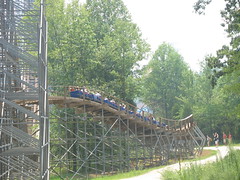 moment on the ride that produces airtime that’s actually fun without wallowing in grandiose self-importance that fails to deliver any real substance.
moment on the ride that produces airtime that’s actually fun without wallowing in grandiose self-importance that fails to deliver any real substance.
But wait, here is the one thing the Voyage finally gets absolutely, spot on correct. That steady, relentless build-up to the end, each second predicated by the one before it as it transforms to a unrestrained twister layout, the rider’s psyche haunted by the screaming zeitgeist which makes any ‘final climax’ at the end unnecessary, because the anticipation from the buildup is more emotionally powerful than any solitary finale by itself can provide. Everything before it, it was all just an act to lure me into the exact psychological state the ride wanted so that it could then blow the lid off with the final run back to the station.
This is what great roller coasters are all about. This is what can finally elevate the roller coaster experience above the class of mere sensorial perception and into an object of beauty, in the Platonic sense of the word. What expands the mind to think of the coaster as something that happens not just in the moment but across space and time, and can’t be understood or quantified in purely scientific, rationalist terms but instead can only be subjectively experienced in a metaphysically humanist capacity.
I clear my mind waiting for the revelation. And it never happens.
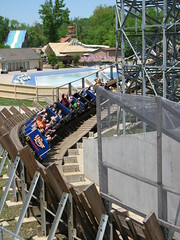 Instead I am just given a string of ‘moments’. A smattering of ‘intensity’. I am once again forced, against my own will, to brace myself, and focus only on getting through the ride from one second to another. A 90° turn eventually comes along and I don’t particularly care; neither does the coaster. My ego tells me this is a great ride, but deep down I’m bored, and maybe just a little bit sad. Is there any higher ideal to be comprehended beneath the surface of enthusiast-pandering ‘intensity’. Probably, but it would take a Zen master to distill it from this furious but empty parade of nonstop self-importance. That probably accounts for that germ of sadness I would rarely in a conscious state admit to, because I know I don’t have the faculties I’d need to get to that core of potential greatness the ride has in it. What I will admit to is feeling a bit queasy, I’ve had enough sensation, by this point it only tastes like ash in my mouth, and just want the ride to be over so I can at least once again regain control over my body from this ride that insists on forcing me around in whichever direction it chooses. The train brakes and everyone is relieved, not because any catharsis has been reached but because it’s finally over.
Instead I am just given a string of ‘moments’. A smattering of ‘intensity’. I am once again forced, against my own will, to brace myself, and focus only on getting through the ride from one second to another. A 90° turn eventually comes along and I don’t particularly care; neither does the coaster. My ego tells me this is a great ride, but deep down I’m bored, and maybe just a little bit sad. Is there any higher ideal to be comprehended beneath the surface of enthusiast-pandering ‘intensity’. Probably, but it would take a Zen master to distill it from this furious but empty parade of nonstop self-importance. That probably accounts for that germ of sadness I would rarely in a conscious state admit to, because I know I don’t have the faculties I’d need to get to that core of potential greatness the ride has in it. What I will admit to is feeling a bit queasy, I’ve had enough sensation, by this point it only tastes like ash in my mouth, and just want the ride to be over so I can at least once again regain control over my body from this ride that insists on forcing me around in whichever direction it chooses. The train brakes and everyone is relieved, not because any catharsis has been reached but because it’s finally over.
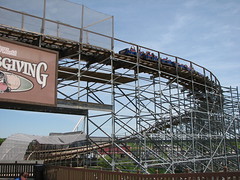 I get off the exit platform and, thinking it all over in my head, I must conclude that the Voyage is a “Great Roller Coaster”. It has every ingredient I thought I’d need out of a roller coaster to be happy, and now that those needs have been fulfilled I’m not any happier walking down the exit ramp than I was before I got on the ride. I feel some guilt for that, and convince myself I need to ride it again, because maybe I wasn’t paying enough attention and somehow missed that fleeting moment of true happiness. But maybe there’s no such thing as true happiness in the metaphysical sense, maybe happiness is only defined by the momentary suspension of pain, and maybe suicide is the only real escape, if only it weren’t so vulgar and pointless an act as well.
I get off the exit platform and, thinking it all over in my head, I must conclude that the Voyage is a “Great Roller Coaster”. It has every ingredient I thought I’d need out of a roller coaster to be happy, and now that those needs have been fulfilled I’m not any happier walking down the exit ramp than I was before I got on the ride. I feel some guilt for that, and convince myself I need to ride it again, because maybe I wasn’t paying enough attention and somehow missed that fleeting moment of true happiness. But maybe there’s no such thing as true happiness in the metaphysical sense, maybe happiness is only defined by the momentary suspension of pain, and maybe suicide is the only real escape, if only it weren’t so vulgar and pointless an act as well.
Shortly after taking the first test rides back in 2006, Will Koch wrote the first review of the Voyage (since taken offline but you can read the archive here) in which he concluded that it represented the beginning of a new era for wooden roller coasters. He was 100% right in concluding that his creation represented a landmark in the history of wooden coasters, but his positioning was turned upside. The Voyage doesn’t represent the start of anything; how can it possibly? It instead represents the end of an era, that of the enthusiast-dominated mindset that declares that the ultimate coaster can be found through non-stop action and intensity, though the maximization of forces or pleasurable sensorial feedback as frequently as possible at every possible moment, and to supply it in as great of abundance as technically feasible until we’ve physically had enough. The Voyage is now at those limits, there is nothing original left that can possibly be added to this formula in the future without making everyone sick to their stomachs. Even if there somehow could be, what would it really add? It can only expand those perceptions of nonstop intensity by an increasingly marginal amount, and then what? Have we reached the zenith of roller coasters? To answer ‘yes’ is to show a total lack of imagination of ways to emotionally connect with the riders in even more profound ways than I’m sure designers even dare are possible. But there’s no way to expand that scope of aesthetic range as I think is achievable through coasters if the only direction they’re allowed to improve in is towards the direction established by the Voyage. When one is being assaulted by non-stop intensity for two-and-a-half minutes, there can be the most inspired of progression and sequencing structures, the most exhilarating of creative spark, or the most divine extrasensorial experiences happening around one… it won’t really matter because the ‘intensity’ will always overpower any of that, the adrenaline causing us to close our minds with the fight or flight mechanism forcing a heightened awareness of only the moment. And as long as that is the case, the roller coaster will never really become anything more than a novelty thrill device.
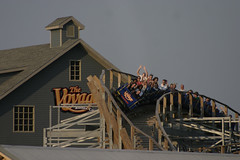 I hope the Voyage remains in the top ten for many years to come. I hope it remains the shining example of the best of this breed of coaster. I hope no matter what innovations may come in the future that it will always be remembered as an all-time classic, and as possibly the most important example to come out of the two decades since the inception of CCI and GCI in the early and mid-90’s that saw the wooden coaster radically evolve from its traditionalist origins. But I also hope we don’t delude ourselves in realizing that, in the year 2006 A.D., that voyage came to an end. Sadly, with the advent of the Timberliner cars, plug-and-play technology and Rocky Mountain Construction’s retrofitted steel track (all pushes further in the direction of solving problems caused by pushing the extremes of intensity in the first place) I don’t think we’re quite ready for that yet. Hopefully we at least can get one or two more Voyages before that time does come. If not, I guess I’ll just sit back and watch with increasing doubt and uncertainty as everything I previously assumed to be true… both the positive and negative side of the same coin… deteriorates as the universe moves towards higher states of entropy.
I hope the Voyage remains in the top ten for many years to come. I hope it remains the shining example of the best of this breed of coaster. I hope no matter what innovations may come in the future that it will always be remembered as an all-time classic, and as possibly the most important example to come out of the two decades since the inception of CCI and GCI in the early and mid-90’s that saw the wooden coaster radically evolve from its traditionalist origins. But I also hope we don’t delude ourselves in realizing that, in the year 2006 A.D., that voyage came to an end. Sadly, with the advent of the Timberliner cars, plug-and-play technology and Rocky Mountain Construction’s retrofitted steel track (all pushes further in the direction of solving problems caused by pushing the extremes of intensity in the first place) I don’t think we’re quite ready for that yet. Hopefully we at least can get one or two more Voyages before that time does come. If not, I guess I’ll just sit back and watch with increasing doubt and uncertainty as everything I previously assumed to be true… both the positive and negative side of the same coin… deteriorates as the universe moves towards higher states of entropy.
(Additional photo credits to Anthony Harrison and Freddie Ross. Used with permission.)

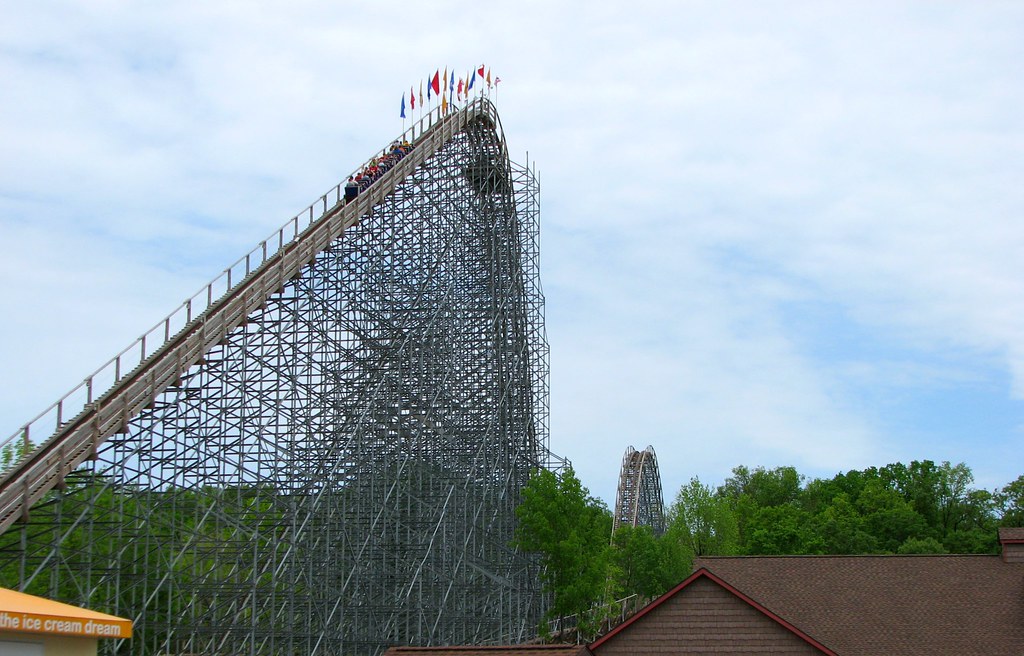
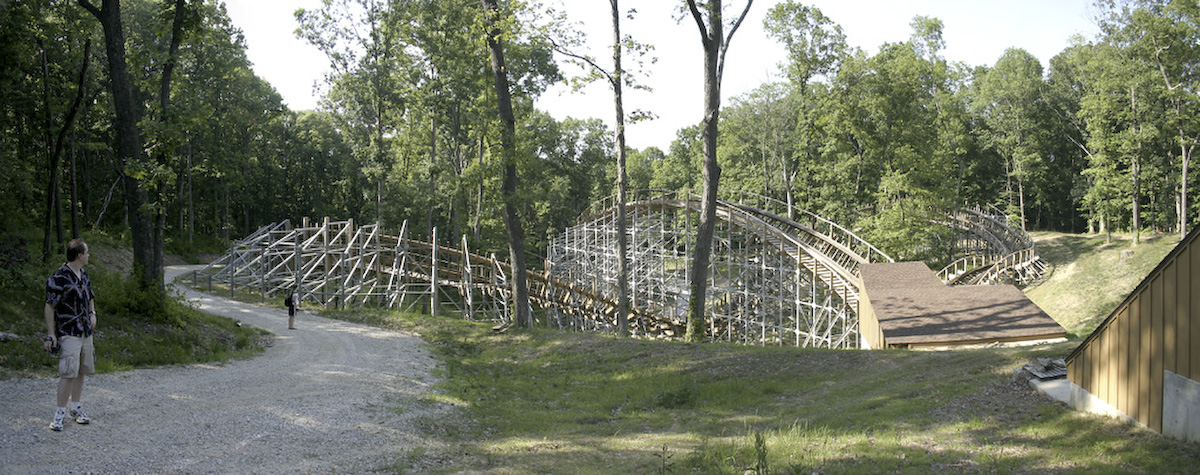

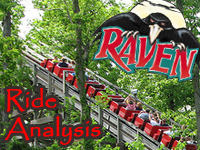

Further discussion can be found on rec.roller-coaster
I agree. 🙂
It’s a bit scary how you can explain a roller coaster so objectively. Until I started reading you analysis’s I believed my experiences were subjective. But it’s all there. You’ve explained everything.
I will inject however that the Voyage’s ego and self-importance would only be exaggerated by a pre-lift segment. That “tremendous psychological impact” you fear might be missing by entering the lift directly only serves to strengthen the blow of the return run by embracing us with it’s assault one step before we’re ready I believe. And with sustained “crescendo” at that.
You’re going to have to review this ride again after riding with the new Timberliners. I’m hoping the overall terrain and airtime might become more apparent when the violence is removed. I’m glad I was able to experience The Voyage as it was but am eager to see how this hybrid evolves. I bet it will be cool.
“I must wearily play along with this game the designers have forced on me for the whole two-and-a-half minute ride by constantly repositioning my body so as to not pull any muscles in my back at each and every turn”
Id have to disagree. Several people I know came off the ride sore or aching. It would purely depend on how seasoned of a coaster rider you are and the style you choose to employ. If you are a ragdoll rider this ride will hurt you, especially the later in the night it runs. If you are more rigid or ride defensively, then, like most any other ride you can protect yourself.
Also, you and I know we both know the ride well and that plays into that sense of anticipating the track ahead, thus, making the whole “Its too controlled” (paraphrased) ideal a little watered down.
I agree, I had it memorized before I rode it and yes, I tend to ride a little defensive. My Father however, who’s still in good condition could only ride a few times before the toll had been taken on his body. Same for several friends I brought down there. They were not accustomed to the lateral and vertical forces employed in conjunction like they are on this ride.
I just feel that part is being used a bit unfairly since I know the kind of rider you are. You ride like me. Its the most out of control ride Ive ever been on aside from Lost Coaster of Superstition Mountain which basically its only purpose is to try and separate your organs from their current positions with impossibly tight radii and undulating transitions. For a high speed full size ride though, it doesn’t play well with others when the “others” aren’t prepared.
Also, think I found a typo
“I’ve had enough sensation, by this point it only takes like ash in my mouth,”
Pretty sure you meant tastes like ash, right?
😛
That concept you pointed out in the ‘critical’ half of the review I should have more carefully explained especially since that’s where I’ve gotten the most criticism. It is clearly a bit paradoxical that I could call a ride too controlled and yet also too intense. What I should have described wasn’t the ride’s intensity in any quantifiable or even many qualitative measures, but rather it’s a sort of ‘contextual’ over-intensity that leaves me feeling numb. By that I mean when I’m being thrown around in an aggressive manner similar to many other rough-and-tumble roller coasters, I’m riding it with the knowledge that it was a conscious choice by the designers to create this sort of sensation, rather than one necessitated by external forces the way older intense rides do.
So for comparison on the Legend, that one might be nearly as intense as the Voyage and I have no problems with it because I feel like I’m getting an authentic experience. I can observe in the trackwork that they have limits for how steep they can bank the track, how long they’re able to predict a transition, how much control they have over the calculus of the train’s movement, etc. Most of the forces felt then aren’t choices by the designers but represent us going beyond the limits of human control. It’s a very intense experience you have to learn how to ride and prepare for, and it’s really very fun.
The Voyage, on the other hand, I am aware that this sort of aggressive intensity was always a conscious choice by the designers to incorporate. I can see how the banking doesn’t remain at a fixed pitch, how they soften transitions that would otherwise be too hard with different techniques, how their camelback hills are all perfectly shaped parabolas, and when the laterals start to feel too out of control, you get a 90 degree banked turn showing they clearly have a lot more control than they’re pretending to not have. So even if the physical experiences turn out to be identical (and I’d argue there are some slight differences anyway; the Voyage is more pure, static g-forces compared to the choppy, unpredictable nature of earlier CCIs) the psychological experience of the force is quite different. We’re much more willing to let nature push us to extremes than we are another human being.
Even then, as the double nature of this review suggests, this is not an absolute criticism and I myself hold contradictory viewpoints on whether or not this assessment is truthful. So you could be right anyway.
Typo doesn’t surprise me, I have pretty bad/lax editorial skills.
Really enjoyed reading your reviews. I agree with most you have said.
There are so many parts of the Voyage that get me. It’s just a relentless ride from start to finish and it fits together perfectly.
I think the brake and triple-down is my favorite element, through. After non-stop abuse on the ride out and spaghetti bowl at the end, we get the expected lull with the brake . . . but the brakes don’t slow the train down nearly as much as I expect them to, almost like a fake-out. So instead of catching my breath, the triple-down sucks the train out from underneath. The Voyage is full of surprises (the dip in the 90 degree turn around, for example), and the second dip in the pitch black of the tunnel is a great one. I remember thinking “You got me!” the first time I rode through. The third dip is the fastest and most violent, and still catches me by surprise if I haven’t ridden in a while. I just assume that there can’t possibly be more . . . but there is.
Great great ride.
C
I’m 6 years late responding to this analysis but it’s a really slow morning at work.
In 2009 my wife and I had the opportunity to visit a ton of parks on the east coast for our honeymoon and ended the trip on El Toro, a coaster that even with all the hype and build up as this intense experience it still blew us away. That ride easily took the #1 spot as our favorite coaster and it wasn’t even an argument.
Cut to a year later we scheduled a trip to Holiday World for our one year anniversary. It seemed fitting that we would ride the other “best coaster in the world” as a nice bookend for our first year of marriage. Same hype, same build up, it was late in the day and we sat in the back for our first ride just like El Toro. I distinctly remember the sickening feeling of disappointment creeping up on me somewhere in the spaghetti bowl. As our train just lazily rolled through the second 90 degree turn and my smile faded along with my excitement. When we disembarked we both tried to say something positive, maybe provide an excuse for why we experienced such a lackluster ride. We tried the front seat and once again the excitement just wasn’t there. Once again the excuses…”maybe it’s just running slow tonight. We’ll try again in the morning.”
And we did. As soon as it opened the next day we got right on and yes the experience was marginally better but the simple fact was the Voyage would not become our favorite coaster. In fact we enjoyed Raven and Legend a lot more as evidenced by the repeated rides on those coasters throughout the weekend. For me the Voyage will stand tall as the most disappointing coaster I’ve ever been on.
I really enjoyed your analysis of The Voyage because it’s very interesting reading the different viewpoints that one can have on this coaster. I hope to go back to Holiday World one day to try it again with the Timberliners (and also ride The Raven again which we absolutely loved).